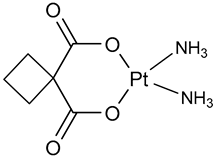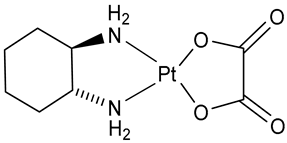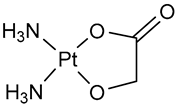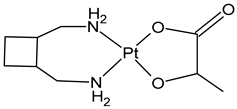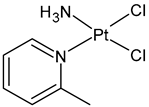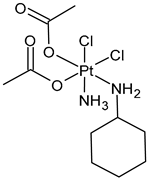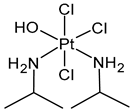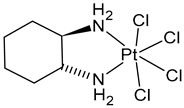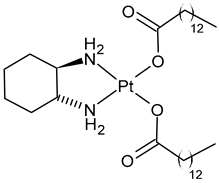Abstract
Cisplatin was the first metal-based anticancer drug introduced into clinical use. It is a “small” molecule, but it represented a very “big” discovery. Since it was introduced on the market, it has not been withdrawn, despite being not free of side effects, owing to its peculiarity of being highly effective in the treatment of cancer. Anticancer activity of the platinum-based complexes was discovered with this molecule; since then, several other platinum-based drugs have been developed and tested in preclinical studies against cancer cells; however, only a few of them reached clinical trials, and their side effects are not much less than cisplatin. Despite the constraints of drug resistance and side effects, chemotherapy remains a fundamental strategy in cancer treatment. Nowadays, cisplatin remains one of the most-used anticancer agents in treating lung, colon, ovary, testicles, bladder, cervix, and many more cancers, although cisplatin resistance represents a major hurdle in cancer treatment. Will there ever be another drug that can overcome the side effects of cisplatin but at the same time be able to block tumors as does cisplatin?
1. Introduction
It has been about 50 years since the serendipitous revolutionary discovery of cisplatin, and it is still very frequently used in chemotherapy [1], remaining the gold standard for solid tumors [2]. Cisplatin is a potent cytostatic drug, belonging to the group of alkylating agents [3], recently also used in genetic studies to predict disease recurrence [4,5]. However, the use is limited by the well-known severe acute and chronic nephro-, oto-, and peripheral neurotoxicity it causes [6,7,8]. For this reason, numerous platin derivatives were further developed with varying degrees of success, but only two of them were approved for clinical use worldwide [9,10,11,12]. They are summarized in Table 1. In 1979, Bristol-Myers Squibb licensed carboplatin, a second-generation platinum drug with fewer side effects, and the third-generation platinum compound oxaliplatin, which was first approved in 2002 under the name of Eloxatin®, as a second-line agent for advanced colorectal cancer. Cisplatin, carboplatin, and oxalilplatin are now registered worldwide. Then, two other platin-based drugs received approval, namely nedaplatin (Aqupla®) in Japan (the first injectable platinum antineoplastic agent to be developed in that country), and lobaplatin, approved in China for the treatment of metastatic breast cancer, small cell lung cancer, and chronic myeloid leukemia [13]. Heptaplatin, often known by its brand name Eptaplatin or Sunpla, is a third-generation platinum drug approved by Korea in 1999 for treatment of solid colorectal tumor [14]. However, the drug also showed significant cytotoxicity, leading to serious adverse effects such alopecia, mucositis, thrombocytopenia, and myelosuppression [15]. Lobaplatin can be viewed as a derivative of heptaplatin in which a cyclobutane ring is fused to the seven-membered chelate ring instead of a functionalised dioxolane. It is a diastereomeric mixture of platinum(II) complexes [16]. Then, picoplatin was designed with the aim to treat cisplatin-resistant cancers to overcome resistance due to interaction with thiol-containing molecules. Chemically, it is a sterically hindered Pt(II) complex with antineoplastic properties. It alkylates DNA via inter- and intrastrand crosslinkages, thus leading to the inhibition of DNA replication and transcription, and inducing apoptosis [17]. However, in phase III clinical trials for advanced cell lung cancer, it failed. It is now under clinical study for other cancer types, such as metastatic colorectal cancer [18]. Other efforts were also made to find new orally administered analogs, leading to satraplatin, a Pt(IV) derivative, bearing two axial acetate groups. Satraplatin showed clinical progress but was not approved by FDA because it did not sufficiently extend the overall survival, yet it has shown a very different toxicity profile than cisplatin. Then, iproplatin, another Pt(IV) derivative, is one of the most clinically studied platinum compounds to have not been yet approved for marketing. The 38 clinical trials ranging from phase I to III conducted on iproplatin did not lead to its marketing approval, as these investigations ultimately concluded that the complex did not demonstrate overall effectiveness superior to that of cisplatin or carboplatin. Ormaplatin (or tetraplatin), tetrachloro(1,2-diaminocyclohexane)platinum(IV), was developed due to a changed toxicity profile and non-cross resistance to cisplatin. Due to significant neurotoxicity it caused at the maximum tolerated dose, ormaplatin did not advance to phase II clinical trials. In 2009, miriplatin, a Pt(II) derivative, was licensed by the Pharmaceuticals and Medical Devices Agency of Japan for the treatment of hepatocellular carcinoma [19]. Miriplatin is a lipophilic platinum complex, slightly soluble in both water and organic solvents, which is used in transcatheter arterial chemoembolization (TACE) [20,21,22]. On the highest tolerated dosage, ormaplatin was seen to cause severe neurotoxicity, and in certain instances, a nontoxic highest-tolerated dosage could not be established [23,24]. Nonetheless, cisplatin remains the first-line therapy for many cancers such as breast, ovarian, testicular, head and neck, bladder, or lung cancers [25]. Although platinum therapy alone is effective against many tumors, cancer cells can adapt to the treatment and gain resistance [26]. Despite the side effects, including the emergence of drug resistance, researchers have so far not found a drug that replaces cisplatin, but typically aim to combine it with other drugs, including natural products [27,28,29], to reduce side effects and/or increase its effectiveness [30]. In this review, the history of cisplatin is briefly summarized, along with the most common uses of this drug, particularly highlighting its usefulness and the need for its use as a life-saving drug in solid cancers.

Table 1.
Platinum compounds in clinical studies and/or in therapy.
2. History of Cisplatin: An “Accidental” Discovery
Cisplatin, or cis-diamminedichloridoplatinum(II) (cis-[PtCl2(NH3)2], DDP), is a platinum metal-based anticancer drug that was first synthesized in 1845, and described as “Peyrone’s salt” or “Peyrone’s chloride” [31]. The first studies of this compound as an anticancer drug date back to 1965. At that time, it was thought that platinum did not have biological activity. The research group of Dr. Barnett Rosenberg was studying the effects of an electric field on the growth of bacteria. They placed platinum electrodes in a solution containing the Gram-negative bacterium Escherichia coli and activated the power [32]. As the current started, the bacterial cells stopped the division, although they continued to grow to up to 300 times their normal length. When the current was stopped, the bacterial cells started to divide again. Thus, the electrical field was supposed to control cell division. Dr. Rosenberg later called this experiment the “accidental discovery that led eventually to cisplatin.” Dr. Rosenberg and his colleagues thought to have found a way to control cell growth with electrical currents, bearing in mind that the platinum-conducting plates were able to induce cell growth while inhibiting cell division. They tried to discover why the electrical field had such a serious effect. After two years, they realized that electricity was not the cause of it. Cell division was not stopped by the electric field, but by a platinum compound released by the electrodes. Thus, Rosenberg hypothesized that, in the same way as bacteria, cisplatin could stop tumor cell growth, which was later confirmed. Indeed, in 1978, six years after clinical trials carried out by the National Cancer Institute (NCI) and Bristol-Myers-Squibb, the U.S. Food and Drug Administration (FDA) approved cisplatin under the name of Platinol® (Bristol-Myers-Squibb; Princeton, NJ) for the therapy of bladder cancer and metastatic ovarian and testicular cancer combined with other drugs [33]. It triggers malignant cell death by binding to nuclear DNA, which appears to be the ultimate target.
3. Mechanism of Action of Cisplatin in Cancer
After absorption in cancer cells, cisplatin interacts with cellular molecules, thus exerting its cytotoxic effects through binding to DNA and forming intra-strand DNA adducts finally leading to the inhibition of DNA synthesis and cell growth [34]. Cisplatin is activated following its entrance into the cytoplasm, replacing chloride atoms with water molecules, forming an electrophile with affinity for -SH groups of proteins and nitrogen donor atoms of nucleic acids [35]. The selective binding of cisplatin with 1,2-intrastrand crosslinks of purine bases triggers cell division arrest and induces cell death by apoptosis. The key molecular mechanism of action is the induction of intrinsic and extrinsic pathways of apoptosis resulting from the production of reactive oxygen species (ROS) through lipid peroxidation, activation of different signal transduction pathways, induction of p53 signaling and cell cycle arrest, upregulation of pro-apoptotic genes/proteins, and downregulation of proto-oncogenes and anti-apoptotic genes/proteins [36]. The most usual cisplatin-DNA adduct formed by covalent binding has been observed at the N7 positions of the imidazole ring of two adjacent guanines, and also to adenosine residues, causing an unwinding and bending of the DNA [37]. Inter- and intrastrand crosslinks and nonfunctional adducts were suggested to contribute to cisplatin toxicity [38]. However, cisplatin, as well as all cytotoxic chemotherapy drugs, such as platinum-based drugs, display severe adverse effects due to the poor selectivity for cancerous cells over normal cells.
4. Side Effects of Cisplatin
Platinum-based chemotherapeutic agents, including cisplatin, are widely used in cancer treatment. However, their indiscriminate action often affects both cancerous and normal cells, leading to severe adverse effects (Figure 1). Common adverse reactions/events of cisplatin are represented by neurotoxicity, nephrotoxicity, hepatotoxicity, ototoxicity; myelosuppression: thrombocytopenia, neutropenia, leukopenia, cardiotoxicity, and gastrointestinal toxicity [39]. Moreover, cisplatin-induced encephalopathy has been suggested, even though it is unusual, and the majority of individuals recover completely without consequences [40]. Several studies are aimed at reducing the toxicity of cisplatin, such as the use of natural products, including papaverine [41] ginsenosides [42], terpenes (rosiridin) [43], berberrubine [44], flavonoids [45], and lutein [46]; and various drugs, including cimetidine—an H2 receptor antagonist [47], acalabrutinib—a tyrosine kinase inhibitor [48], irosustat—a first-generation, irreversible steroid sulfatase inhibitor [49], olaparib—a poly (ADP-ribose) polymerase (PARP) inhibitor [50], N-acetylcysteine [51], and deferiprone—an iron chelator [52]. Further complicating matters is the emergence of chemotherapy resistance during cisplatin treatment, which compromises the clinical efficacy of this drug and frequently culminates in treatment failure [53]. The mechanisms for cisplatin resistance include low DNA damage formation, high DNA repair capacity, reduced cisplatin uptake/increased efflux, and cisplatin inactivation changes in apoptosis signaling pathways and rewired cell metabolisms. Resistance to cisplatin can be mediated by protective macroautophagy (commonly known as autophagy), a dysregulated cell death mechanism often observed during chemotherapy that is able to suppress apoptosis. Additionally, autophagy-related changes in tumor cell metastasis, specifically the induction of epithelial–mesenchymal transition (EMT), may be also responsible for cisplatin resistance [54]. Finally, with the use of combination therapy, the emergence of multidrug resistance in cancer cells prevented the achievement of the desired therapeutic effect even with the accurate combination of two chemotherapeutic drugs.
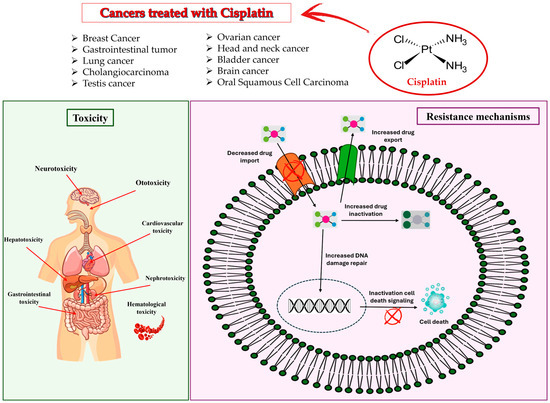
Figure 1.
Toxicity and mechanisms of cisplatin resistance.
5. Uses of Cisplatin in Cancer
Cisplatin is a broad-spectrum anticancer drug still used in the treatment of various forms of carcinomas and sarcomas [55]. Given the numerous side effects of cisplatin, some research concerns studies of drugs or natural products to use in combination with the classic platinum compounds, with the aim of using a lower dose of chemotherapy [56,57,58].
5.1. Breast Cancer
Breast cancer was the most frequent cause of cancer death in women in 2022 [59]. Although recent in vitro studies are often addressed to the design and evaluation of new platinum complexes, both Pt(II) and Pt(IV), to be used to overcome side effects of the “old drugs” [60], the metal-based alkylating drug cisplatin, along with carboplatin and lobaplatin, are still currently employed in clinical settings, particularly for worst types of BC, represented by triple negative breast cancer (TNBC), early TNBC (eTNBC), metastatic breast cancer (MBC), and metastatic TNBC (mTNBC) [61,62,63]. Recently, monotherapy with cisplatin has been suggested as a treatment option for patients with HER-2 negative BC who had hepatic visceral crisis (VC) or impending visceral crisis (IVC), for which limited data exists on systemic treatments [64]. Shi et al. (2024) [65] evidenced that cisplatin could be a potential option in patients with performance status 0 or 1 experiencing hepatic IVC/VC, regardless of liver function parameters. Cisplatin combined with paclitaxel or nab-paclitaxel is the preferred first-line treatment for mTNBC. The management of MBC poses a significant clinical challenge due to its high incidence of drug resistance and the limited efficacy of conventional therapies. Some authors also suggest the use of natural products to reverse cisplatin resistance in TNBC [66]. A recent study demonstrated that metronomic chemotherapy of low-dose weekly paclitaxel and cisplatin compared with the control group offers clinically meaningful benefits in improving PFS for patients with MBC, particularly in first-line treatment settings [67]. Smothers et al. (2025) [68] demonstrated that combining cisplatin with tumor-treating fields induced higher levels of apoptosis in TNBC cells, opposite to normal epithelial cells. Moreover, a lower dose of chemotherapy could be used to achieve the same efficacy of higher doses of individual therapy. Recently, the FOXD1/KIFC1 (Forkhead Box D1/Kinesin family member C1) axis linked the glycolysis pathway to cisplatin resistance and has been suggested as a promising new target for reinforcing resistance to cisplatin in breast cancer [69].
5.2. Gastrointestinal Tumor
The major malignant tumors involving the gastrointestinal tract still use chemotherapy as a potential tool for tumor suppression and reduction in tumor metastasis. Gastric cancer is the fifth cancer and the fourth cause of cancer death worldwide [70,71]. Colorectal cancer is a leading cause of death and inflammation; hepatocellular carcinoma is the most common primary liver malignancy and remains the third major cause of cancer-related mortality in the world [72]. Despite the rapid development of diagnostic and treatment strategies for these cancers, the prognosis for these patients is still unsatisfactory [73]. Cisplatin is an option for the treatment of advanced gastric cancer, colorectal cancer, and hepatocellular carcinoma [2,74,75]; however, the changes in autophagic status induce its resistance, thus severely limiting its efficacy. When this occurs, the use of anticancer drugs for autophagy control may alter the response of tumor cells to cisplatin chemotherapy.
5.3. Lung Cancer
Lung cancer represents one of the most prevalent cancers in the world, being the second most diagnosed cancer in both men and women but the most common type of cancer death, making about 16.7% of the total cancer burden and having caused more deaths in 2020 than breast, colorectal, and prostate cancers in combination [76]. However, most patients had non-small cell lung cancer (NSCLC) recurrence after curative purpose surgery, which evidences the aggressiveness of this illness. Patients with advanced NSCLC along with patients with early-stage illness needing adjuvant therapy generally use cisplatin [77]. However, its usefulness is limited by the onset of resistance. Several new strategies are studied for combating cisplatin-resistant lung cancer [78,79,80].
5.4. Cholangiocarcinoma
Cholangiocarcinoma occurs in the biliary tree and/or the parenchyma of the liver and is a highly lethal form of cancer. The global KEYNOTE-966 trial, carried out at 175 medical centers, evaluated the efficacy of pembrolizumab in association with gemcitabine (GC) and cisplatin versus GC alone in patients with cholangiocarcinoma, finding that there was no improvement with the combined therapy and that GC alone remains the best treatment option [81].
5.5. Testis Cancer
Testicular cancer is the leading cancer in young men. Germ cell tumors are the most common cancer entity in young males aged between 20 and 40 years [82]. Cisplatin-based chemotherapy is standard-of-care with a generally excellent response, but contributes to morbidities that can impact health-related quality of life and may adversely affect long-term survival [83].
5.6. Ovarian Cancer
Ovarian cancer is one of the most life-threatening gynecological malignancies, ranking among the deadliest cancers in the world [84]. In 2020, it was the eighth most diagnosed malignancy in the world and affects about 314,000 women and also ranking as the eighth most deadly cancer, with more than 207,000 attributed deaths [85]. It is often being diagnosed at a late-stage, that is, when the disease is already advanced. This makes it known as the “silent killer” due to its high mortality rate among women [86]. Platinum-based chemotherapy, including cisplatin, is a mainstay of ovarian cancer treatment [87]. Traditionally, the front-line approach involves cytoreductive surgery which is followed by intravenous chemotherapy with cisplatin or carboplatin generally combined with paclitaxel or docetaxel every 21 days for six cycles [88]. However, the high mortality rate is mainly attributed to the frequent development of lower efficacy and even emergence of resistance to cisplatin [89].
5.7. Head and Neck Cancer
Cisplatin chemoradiotherapy is a standard for locally advanced head and neck squamous cell carcinoma patients [90,91]. It is used in a low weekly dose or a high dose once every 3 weeks [92]. To prevent cisplatin-induced hearing loss, patients often receive hydration before and after cisplatin infusions [93]. Recent studies suggest the use of short hydration as a valid alternative to conventional hydration protocol in the prevention of cisplatin-related nephrotoxicity in head and neck cancer [94].
5.8. Bladder Cancer
Bladder cancer (BCa) is the ninth most common malignant tumor globally, with approximately 500,000 new cases and 200,000 deaths reported each year [95]; over 614,000 new cases were diagnosed in 2022 [96]. Urothelial carcinoma is the most common histological type of BCa, with about 70% of cases being non-muscle invasive and 30% muscle-invasive [97]. Cisplatin-based combination chemotherapy is the standard first-line treatment approach for metastatic BCa; however, most patients who are initially sensitive to cisplatin eventually develop resistance [98]. Resistance to cisplatin in patients with BCa has evidenced the pivotal role of lactylation. By using single-cell RNA sequencing, it was observed that H3 lysine 18 lactylation (H3K18la) plays a crucial role in the activation of target genes transcription by enrichment in their promoter regions. Targeted inhibition of H3K18la successfully restored the sensitivity to cisplatin in these cisplatin-resistant epithelial cells [99]. Circular RNAs (circRNAs) are extensively recognized for their role in the development and advancement of BCa [100], even though the precise mechanisms through which circRNAs govern resistance have not yet been fully clarified [101]. Wei et al. (2024) [102] demonstrated that circRNAs, specifically circSTX6, plays a major role in BCa metastasis and cisplatin resistance. Recently, SRC was reported to enhance cisplatin resistance in BCa by reprogramming glycolysis and the pentose phosphate pathway. Most of the glycolysis and pentose phosphate pathway intermediates were enhanced in cisplatin-resistant tissues in comparison with those in cisplatin-sensitive patients [103].
5.9. Brain Cancer
The limit of chemotherapy treatment of brain tumors is the presence of the blood–brain barrier (BBB), which limits the entrance of these kinds of drugs into the brain. When the entrance of chemotherapy drugs is improved, their efficacy is limited by drug resistance. The risk of cisplatin resistance in glioma is rather high, likely because of the aggressive behavior of cancer cells. Pro-survival autophagy may induce cisplatin resistance in glioma. Nanoparticle-based strategies for targeting autophagy and enhancing cisplatin sensitivity are being considered [104]. Glioblastoma multiforme is the most malignant primary brain tumor, which is generally treated with surgery, radiotherapy, and/or chemotherapy; the efficacy of cisplatin treatment also remains limited due to high recurrence rates and drug resistance, resulting in a 5-year survival rate of less than 6%. Hao et al. (2025) [105] recently suggested the use of a biomimetic nanocomposite to facilitate the targeted delivery and blood–brain barrier penetration of cisplatin, thereby inducing pyroptosis in glioblastoma multiforme cells and promoting immune activation. Moreover, the use of polymer-based nanomedicines is under study [106].
5.10. Oral Squamous Cell Carcinoma
Oral squamous cell carcinoma ranks as the sixth most common malignancy worldwide, with the tongue being the most frequently affected site. Cisplatin is the standard chemotherapy for oral squamous cell carcinoma, but resistance often reduces its efficacy, necessitating new treatments with fewer side effects.
5.11. Brain Metastases and Leptomeningeal Metastases
Brain metastases (BMs) and leptomeningeal metastasis (LM) still affect a large number of people. BMs generally derive from breast cancer, melanoma, kidney cancer, colorectal cancer, small cell lung cancer (SCLC) [107], non-small cell lung cancer (NSCLC) [108,109,110], and testicular cancer [111]. Although therapeutic advances have prolonged survival for patients with breast cancer, central nervous system metastases have become an increasingly prevalent complication, affecting 20% to 35% of patients with metastatic disease. However, progress in treatments for brain metastases from breast cancer (BMBC) are still limited. More than 70% of patients with BMBC have multiple lesions and are not candidates for local surgery or stereotactic radiosurgery. Palliative whole-brain radiotherapy (WRBT) remains the standard treatment for scattered inoperable metastases. The use of chemotherapics, including cisplatin, is still currently used in therapy and in several clinical trials. A recent study by Chen et al. (2024) [112] evidenced that the use of chemotherapics before WRBT may improve BMBC control. Specifically, the use of cisplatin in combination with bevacizumab and etoposide (BEEP) before WBRT may improve the control of BMBC in comparison to the use of upfront WBRT, which could address an unmet need for an efficient systemic treatment for intractable brain and extracranial metastases from MBC. Cisplatin in combination with vinblastine and temozolomide (CVT) was widely used in the pre-immune checkpoint inhibitors era. However, a recent article by Doolittle et al. (2024) [113] described the use of CVT regimen in patients with relapsed refractory melanoma (RRM) with brain metastases who are ineligible for clinical trials, finally finding that this is an efficient and well-tolerated regimen that can serve as a bridge until a trial becomes available. Brain metastases may derive from metastatic testicular cancer. Systemic chemotherapy is generally the first treatment in asymptomatic patients diagnosed with brain metastases. Cisplatin and etoposide hold good brain penetration and therefore bleomycin, etoposide, and cisplatin (BEP) or vindesine–ifosfamide–platinum (VIP) are the regimens of choice [114]. Brain metastasis in nasopharyngeal carcinoma is a devastating condition that generally occurs through hematogenous dissemination. Systemic therapy is still the main therapy, whereas local therapy for brain metastases may further ameliorate survival in selected patients’ regimens, including cases of GP regimen (gemcitabine, cisplatin), TP regimen (docetaxel, cisplatin), and PF regimen (cisplatin, fluorouracil) [115]. Kobayashi et al. (2024) [116] reported a case of a patient with lung adenocarcinoma who developed liver and brain metastases during adjuvant atezolizumab therapy, with histological transformation from non-small cell to small cell lung cancer (SCLC), a resistance mechanism to immune checkpoint inhibitors. The patient was treated with four cycles of durvalumab associated with cisplatin and etoposide, followed by maintenance therapy with durvalumab. Sustained tumor regression was observed. A phase II trial (NCT04303988), still in recruitment, examines the combination of SHR-1316 (an anti-PD-L1) with bevacizumab and cisplatin/carboplatin in patients with TNBC with active brain metastases [117].
Leptomeningeal metastasis, also called leptomeningeal carcinomatosis (LM), occurs secondary to the metastatic distribution of cancer cells from extracranial and certain intracranial malignancies into the leptomeninges, the cerebrospinal fluid-filled tissues surrounding the central nervous system, and cerebrospinal fluid [118]. LM occurs in 5–10% of patients with solid tumors and portends a bleak clinical prognosis [119]. Immune checkpoint inhibitors have shown clinical benefit in NSCLC-derived brain metastasis, but their efficacy in lung-to-leptomeningeal brain metastasis is still poor [120]. BEEP regimen (with cisplatin) is still used for LM, generally significantly improving overall survival [112,121,122]. However, some authors demonstrated limited penetration of cisplatin in the central nervous system [123,124].
6. Conclusions
In the last few decades, drug discovery has seen a surge in development of efficient anticancer agents offering a real chance of prolonging remission from diverse forms of cancer, improving the quality of life and survival of patients, and sometimes even curing patients from the disease. The use of new and old anticancer drugs, however, continues to be persistently hampered by the emergence of drug resistance in cancer cells through extrinsic and intrinsic mechanisms. Platinum-based compounds are among the most-used chemotherapeutics to treat a wide variety of carcinomas and sarcomas. The alkylating agent cisplatin is one of the most effective and commonly used chemotherapeutics. It is the first-in-class and is still widely used today for the treatment of various types of cancers, such as ovarian, testicular, and colorectal carcinomas, sarcomas, and lymphomas. Although cisplatin has played a huge role, resistance to this drug in tumors has become one of the major clinical problems. Several mechanisms and challenges of cancer drug resistance have been proposed, one of the challenging aspects of anti-cancer treatment in which cancer cells become forbearing to the treatment, thus worsening the conditions of patients. Among them, therapeutic targeting of autophagy or the pathways associated to it, holds potential for restoring cisplatin sensitivity, highlighting this as an important direction for future clinical research. Several recent studies are researching potential alternatives to cisplatin, but will it ever be replaced by equally effective drugs for the treatment of tumors? In the next 50 years, will researchers be able to answer this question? Will artificial intelligence help physicians in overcoming resistance and predicting response to cytotoxic chemotherapy?
Author Contributions
Conceptualization, A.C. and P.L.; methodology, A.M., J.C. and C.S.; data curation, A.M. and A.C.; writing—original draft preparation, A.M. and A.C.; writing—review and editing, J.C., M.S.S. and P.L.; supervision, M.S.S. and P.L. All authors have read and agreed to the published version of the manuscript.
Funding
This work was supported by PRIN 2022, Code 2022HARH5W—HyMTA (Hybrid Multi-Target Agents): Synthesis and biological evaluation of chimeric hybrid molecules containing NHC-metal complexes and carbazole moieties, as innovative multi-target anticancer and antiviral agents (CUP MASTER: C53D23004490001).
Data Availability Statement
No new data were created.
Conflicts of Interest
The authors declare no conflicts of interest.
Abbreviations
The following abbreviations are used in this manuscript:
| BEEP | Bevacizumab-etoposide-cisplatin |
| BC | Breast cancer |
| BCa | Bladder cancer |
| BEP | Bleomycin–etoposide–cisplatin |
| BM | Brain metastases |
| BMBC | Brain metastases from breast cancer |
| circRNAs | Circular RNAs |
| CVT | Cisplatin–vinblastine–temozolomide |
| EMT | Epithelial–mesenchymal transition |
| ES-SCLC | Extensive small cell lung cancer |
| FDA | Food and Drug Administration |
| GC | Gemcitabine and cisplatin |
| IVC | Impending visceral crisis |
| LM | Leptomeningeal |
| MBC | Metastatic breast cancer |
| mTNBC | Metastatic triple-negative breast cancer |
| NAX | Neoadjuvant chemotherapeutics |
| NCI | National Cancer Institute |
| NSCLC | Non-small cell lung cancer |
| PF | Cisplatin–fluorouracil |
| RRM | Relapsed refractory melanoma |
| SCLC | Small cell lung cancer |
| TACE | Transcatheter arterial chemoembolization |
| TNBC | Triple negative breast cancer |
| TP | Docetaxel–cisplatin |
| VC | Visceral crisis |
| VIP | Vindesine–ifosfamide–platinum |
| WRBT | Palliative whole-brain radiotherapy |
References
- Romani, A.M. Cisplatin in cancer treatment. Biochem. Pharmacol. 2022, 206, 115323. [Google Scholar] [CrossRef] [PubMed]
- Koumaki, K.; Skarmalioraki, S.; Kosmidou, V.; Krikoni, L.; Goulielmaki, M.; Zoumpourlis, V.; Pintzas, A.; Souliotis, V.L. Antitumorigenic Effect of Combination Treatment with BRAF Inhibitor and Cisplatin in Colorectal Cancer In Vitro and In Vivo. Adv. Ther. 2025, 8, 2400250. [Google Scholar] [CrossRef]
- Lajous, H.; Lelièvre, B.; Vauléon, E.; Lecomte, P.; Garcion, E. Rethinking Alkylating (-like) Agents for Solid Tumour Management. Trends Pharmacol. Sci. 2019, 40, 342–357. [Google Scholar] [CrossRef] [PubMed]
- Wang, G.; Wang, J.; Li, C.; Mu, X.; Mu, Q.; Zhang, X.; Su, X. ZNF703 Promotes Triple-Negative Breast Cancer Cell Progression and in Combination with STK11 Predicts Disease Recurrence (ZS− TNBC Model). Gene 2025, 942, 149258. [Google Scholar] [CrossRef] [PubMed]
- Borgmann, K.; Krug, D. BRCAness Identifies Synthetic Cytotoxicity Between Cisplatin and Radiation Therapy. Int. J. Radiat. Oncol. Biol. Phys. 2025, 121, 780–782. [Google Scholar] [CrossRef] [PubMed]
- Tang, C.; Livingston, M.J.; Safirstein, R.; Dong, Z. Cisplatin Nephrotoxicity: New Insights and Therapeutic Implications. Nat. Rev. Nephrol. 2023, 19, 53–72. [Google Scholar] [CrossRef] [PubMed]
- Wang, X.; Zhou, Y.; Wang, D.; Wang, Y.; Zhou, Z.; Ma, X.; Liu, X.; Dong, Y. Cisplatin-Induced Ototoxicity: From Signaling Network to Therapeutic Targets. Biomed. Pharmacother. 2023, 157, 114045. [Google Scholar] [CrossRef] [PubMed]
- Becker, G.; Atuati, S.F.; Oliveira, S.M. G Protein-Coupled Receptors and Ion Channels Involvement in Cisplatin-Induced Peripheral Neuropathy: A Review of Preclinical Studies. Cancers 2024, 16, 580. [Google Scholar] [CrossRef] [PubMed]
- León, I.E. Transition Metal Complexes: A New Generation of Anticancer Drugs. Fut. Med. Chem. 2024, 16, 1727–1730. [Google Scholar] [CrossRef] [PubMed]
- Sheikh, H.K.; Ortiz, C.J.C.; Arshad, T.; Padrón, J.M.; Khan, H. Advancements in Steroidal Pt (II) & Pt (IV) Derivatives for Targeted Chemotherapy (2000–2023). Eur. J. Med. Chem. 2024, 271, 116438. [Google Scholar] [CrossRef] [PubMed]
- Sahoo, D.; Deb, P.; Basu, T.; Bardhan, S.; Patra, S.; Sukul, P.K. Advancements in Platinum-Based Anticancer Drug Development: A Comprehensive Review of Strategies, Discoveries, and Future Perspectives. Bioorg. Med. Chem. 2024, 112, 117894. [Google Scholar] [CrossRef] [PubMed]
- Lucaciu, R.L.; Hangan, A.C.; Sevastre, B.; Oprean, L.S. Metallo-Drugs in Cancer Therapy: Past, Present and Future. Molecules 2022, 27, 6485. [Google Scholar] [CrossRef] [PubMed]
- Wang, C.; Yuan, L.; Wu, X.; Wang, Y.; Tian, H.; Zhang, G.; Wan, A.; Xiong, S.; Wang, C.; Zhou, Y.; et al. Taxane Combined with Lobaplatin or Anthracycline for Neoadjuvant Chemotherapy of Triple-Negative Breast Cancer: A Randomized, Controlled, Phase II Study. BMC Med. 2024, 22, 252. [Google Scholar] [CrossRef] [PubMed]
- Li, X.J.; Nie, P.; Herdewijn, P.; Sun, J.G. Unlocking the Synthetic Approaches and Clinical Application of Approved Small-Molecule Drugs for Gastrointestinal Cancer Treatment: A Comprehensive Exploration. Eur. J. Med. Chem. 2023, 262, 115928. [Google Scholar] [CrossRef] [PubMed]
- Huang, X.; Zhou, H.; Jiao, R.; Liu, H.; Qin, C.; Xu, L.; Chen, Y. Supramolecular Chemotherapy: Host–Guest Complexes of Heptaplatin-Cucurbit [7]Uril toward Colorectal Normal and Tumor Cells. Langmuir 2021, 37, 5475–5482. [Google Scholar] [CrossRef] [PubMed]
- McKeage, M.J. Lobaplatin: A New Antitumour Platinum Drug. Exp. Opin. Investig. Drugs 2001, 10, 119–128. [Google Scholar] [CrossRef] [PubMed]
- Singh, R.; Malhotra, A.; Bansal, R. Synthetic cytotoxic drugs as cancer chemotherapeutic agents. In Medicinal Chemistry of Chemotherapeutic Agents; Elsevier: Amsterdam, The Netherlands, 2023; pp. 499–537. [Google Scholar]
- Acharya, P.C.; Kurosu, M. Medicinal Chemistry of Chemotherapeutic Agents: A Comprehensive Resource of Anti-Infective and Anti-Cancer Drugs; Academic Press: Cambridge, MA, USA, 2023; pp. 363–396. ISBN 9780323905756. [Google Scholar]
- Tanaka, T. Transarterial Chemoembolization for Hepatocellular Carcinoma: Current Role and Techniques. Intervent. Radiol. 2025, 10, e2024-0016. [Google Scholar] [CrossRef] [PubMed]
- Wang, X.; Wang, M.; Cai, M.; Shao, R.; Xia, G.; Zhao, W. Miriplatin-Loaded Liposome, as a Novel Mitophagy Inducer, Suppresses Pancreatic Cancer Proliferation through Blocking POLG and TFAM-Mediated mtDNA rRplication. Acta Pharm. Sin. B 2023, 13, 4477–4501. [Google Scholar] [CrossRef] [PubMed]
- Ikeda, M.; Kudo, M.; Aikata, H.; Nagamatsu, H.; Ishii, H.; Yokosuka, O.; Torimura, T.; Morimoto, M.; Ikeda, K.; Kumada, H.; et al. Transarterial Chemoembolization with Miriplatin vs. Epirubicin for Unresectable Hepatocellular Carcinoma: A Phase III Randomized Trial. J. Gastroenterol. 2018, 53, 281–290. [Google Scholar] [CrossRef] [PubMed]
- Ishikawa, T. Efficacy and Features of Balloon-Occluded Transarterial Chemoembolization for Hepatocellular Carcinoma: A Narrative Review. Transl. Gastroenterol. Hepatol. 2024, 9, 48. [Google Scholar] [CrossRef] [PubMed]
- Nath, S.; Datta, A.; Das, A.; Adhikari, S. Metal-Based Drugs in Cancer Therapy. Int. J. Exp. Res. Rev. 2024, 37, 159–173. [Google Scholar] [CrossRef]
- Johnstone, T.C.; Suntharalingam, K.; Lippard, S.J. The Next Generation of Platinum Drugs: Targeted Pt(II) Agents, Nanoparticle Delivery, and Pt(IV) Prodrugs. Chem. Rev. 2016, 116, 3436–3486. [Google Scholar] [CrossRef] [PubMed]
- Bełdzińska, P.; Galikowska-Bogut, B.; Zakrzewski, M.; Bury, K.; Jamrógiewicz, M.; Wyrzykowski, D.; Gołuński, G.; Sądej, R.; Piosik, J. Platinum as Both a Drug and Its Modulator—Do Platinum Nanoparticles Influence Cisplatin Activity? Chem. Biol. Interact. 2025, 407, 111365. [Google Scholar] [CrossRef] [PubMed]
- Khan, S.U.; Fatima, K.; Aisha, S.; Malik, F. Unveiling the Mechanisms and Challenges of Cancer Drug Resistance. Cell Commun. Signal. 2024, 22, 109. [Google Scholar] [CrossRef] [PubMed]
- Dasari, S.; Nijiki, S.; Mbemi, A.; Yedjou, C.G.; Tchounwou, P.B. Pharmacological Effects of Cisplatin Combination with Natural Products in Cancer Chemotherapy. Int. J. Mol. Sci. 2022, 23, 1532. [Google Scholar] [CrossRef] [PubMed]
- Li, K.; Li, J.; Li, Z.; Men, L.; Zuo, H.; Gong, X. Cisplatin-Based Combination Therapies: Their Efficacy with a Focus on Ginsenosides Co-administration. Pharmacol. Res. 2024, 203, 107175. [Google Scholar] [CrossRef] [PubMed]
- Yang, C.; Deng, X.; Tang, Y.; Tang, H.; Xia, C. Natural Products Reverse Cisplatin Resistance in the Hypoxic Tumor Microenvironment. Cancer Lett. 2024, 598, 217116. [Google Scholar] [CrossRef] [PubMed]
- Zoń, A.; Bednarek, I. Cisplatin in Ovarian Cancer Treatment—Known Limitations in Therapy Force New Solutions. Int. J. Mol. Sci. 2023, 24, 7585. [Google Scholar] [CrossRef] [PubMed]
- Kauffman, G.B.; Pentimalli, R.; Doldi, S.; Hall, M.D. Michele Peyrone (1813–1883), Discoverer of Cisplatin. Platin. Met. Rev. 2010, 54, 250–256. [Google Scholar] [CrossRef]
- The “Accidental” Cure—Platinum-Based Treatment for Cancer: The Discovery of Cisplatin. Available online: https://www.cancer.gov/research/progress/discovery/cisplatin (accessed on 28 April 2025).
- Monneret, C. Platinum anticancer drugs. From Serendipity to Rational Design. Ann. Pharm. Fr. 2011, 69, 286–295. [Google Scholar] [CrossRef] [PubMed]
- Cepeda, V.; Fuertes, M.A.; Castilla, J.; Alonso, C.; Quevedo, C.; Pérez, J.M. Biochemical Mechanisms of Cisplatin Cytotoxicity. Anticancer Agents Med. Chem. 2007, 7, 3–18. [Google Scholar] [CrossRef] [PubMed]
- Alderden, R.A.; Hall, M.D.; Hambley, T. The Discovery and Development of Cisplatin. J. Chem. Educ. 2006, 83, 728–734. [Google Scholar] [CrossRef]
- Bragado, P.; Armesilla, A.; Silva, A.; Porras, A. Apoptosis by Cisplatin Requires p53 Mediated p38alpha MAPK Activation through ROS Generation. Apoptosis 2007, 12, 1733–1742. [Google Scholar] [CrossRef] [PubMed]
- Oh, J.; Xu, J.; Chong, J.; Wang, D. Molecular basis of transcriptional pausing, stalling, and transcription-coupled repair initiation. Biochim. Biophys. Acta Gene Regul. Mech. 2021, 1864, 194659. [Google Scholar] [CrossRef]
- Tchounwou, P.B.; Dasari, S.; Noubissi, F.K.; Ray, P.; Kumar, S. Advances in Our Understanding of the Molecular Mechanisms of Action of Cisplatin in Cancer Therapy. J. Exp. Pharmacol. 2021, 13, 303–328. [Google Scholar] [CrossRef] [PubMed]
- Oun, R.; Moussa, Y.E.; Wheate, N.J. The Side Effects of Platinum-Based Chemotherapy Drugs: A Review for Chemists. Dalton Trans. 2018, 47, 6645–6653. [Google Scholar] [CrossRef] [PubMed]
- Jebrouni, F.; Bailal, H.; Omari, M.; Khater, K.; Bali, A.; Al Jarroudi, O.; Brahmi, S.A.; Afqir, S. Management of Cisplatin-Induced Encephalopathy: A Case Report and Literature Review. Cureus 2024, 16, e62176. [Google Scholar] [CrossRef] [PubMed]
- Abass, S.A.; Elgazar, A.A.; El-Kholy, S.S.; El-Refaiy, A.I.; Nawaya, R.A.; Bhat, M.A.; Farrag, F.A.; Hamdi, A.; Balaha, M.; El-Magd, M.A. Unraveling the Nephroprotective Potential of Papaverine against Cisplatin Toxicity through Mitigating Oxidative Stress and Inflammation: Insights from In Silico, In Vitro, and In Vivo Investigations. Molecules 2024, 29, 1927. [Google Scholar] [CrossRef] [PubMed]
- Wang, L.; Hao, X.; Li, X.; Li, Q.; Fang, X. Effects of ginsenoside Rh2 on cisplatin-induced nephrotoxicity in renal tubular epithelial cells by inhibiting endoplasmic reticulum stress. J. Biochem. Mol. Toxicol. 2024, 38, e23768. [Google Scholar] [CrossRef]
- Kazmi, I.; Altayb, H.N.; Al-Abbasi, F.A.; Alharbi, K.S.; Almalki, N.A.R.; Moglad, E.; Al-Qahtani, S.D.; Bawadood, A.S.; Sayyed, N. Rosiridin Prevents Cisplatin-Induced Renal Toxicity by Inhibiting Caspase-3/NF-κB/Bcl-2 Signaling Pathways in Rats and In Silico Study. Naunyn-Schmiedeberg’s Arch. Pharmacol. 2025, 398, 5895–5913. [Google Scholar] [CrossRef] [PubMed]
- Miao, Z.; Chang, D.; Du, X.; Sun, C. Berberrubine Protects Against Cisplatin-Induced Ototoxicity by Promoting Folate Biosynthesis. Front. Pharmacol. 2025, 15, 1496917. [Google Scholar] [CrossRef] [PubMed]
- Zhang, X.; Qian, J.; Wei, B.; Zhang, B. Flavonoids as modulators of Nrf2 signaling pathway in alleviating cisplatin-induced organ toxicity. Yangtze Med. 2025, 9, 52–77. [Google Scholar] [CrossRef]
- Aktas, I.; Gur, F.M.; Bilgiç, S. Protection of Lutein against the Toxic Effect of Cisplatin on Liver in Male Rat. Prostaglandins Other Lipid Mediat. 2025, 178, 106995. [Google Scholar] [CrossRef] [PubMed]
- Sinha, R.; Liu, S.J.; Lee, R.; Boyd, J.; Geary, K.; Zhang, D. Using Cimetidine to Mitigate Cisplatin-Induced Ototoxicity. Toxicol. In Vitro 2025, 104, 106025. [Google Scholar] [CrossRef] [PubMed]
- Hazem, S.H.; Saad, K.M.; Samaha, M.M. Protective Effects of BTK Inhibition by Acalabrutinib on Cisplatin-Induced Renal and Testicular Injury in Mice: Modulation of mTOR/AMPK, NLRP3/GSDMD-N, and Apoptotic Pathways. Int. Immunopharmacol. 2025, 149, 114256. [Google Scholar] [CrossRef] [PubMed]
- Anbar, H.S.; Radi, A.W.; Shaker, H.A.; Janoudi, L.F.; Zain, H.N.A.; Hassan, H.M.; Hersi, F.; El-Gamal, M.; Dohle, W.; Potter, B.V.L.; et al. Protective Potential of Irosustat, STX140 and the Sulfonate Derivative 1G in Counteracting Cisplatin-Induced Renal and Hepatic Toxicities: An In Vivo Comparative Study. Life Sci. 2025, 378, 123793. [Google Scholar] [CrossRef] [PubMed]
- Matsumura, M.; Fujihara, H.; Maita, K.; Miyakawa, M.; Sakai, Y.; Nakayama, R.; Ito, Y.; Hasebe, M.; Kawaguchi, K.; Hamada, Y. Combinatorial Effects of Cisplatin and PARP Inhibitor Olaparib on Survival, Intestinal Integrity, and Microbiome Modulation in Murine Model. Int. J. Mol. Sci. 2025, 26, 1191. [Google Scholar] [CrossRef] [PubMed]
- Zavala-Valencia, A.C.; Velasco-Hidalgo, L.; Martínez-Avalos, A.; Castillejos-López, M.; Torres-Espíndola, L.M. Effect of N-Acetylcysteine on Cisplatin Toxicity: A Review of the Literature. Biol. Targets Ther. 2024, 18, 7–19. [Google Scholar] [CrossRef] [PubMed]
- Seddiek, H.; Hanna, M.; Hamoud, A.E.M.; Elbaset, M.A.; Akabawy, A.M.; Kotb, M.Z.; Khalifa, M.M. Deferiprone Ameliorates Cisplatin Induced Peripheral Neurotoxicity via Ferritinophagy Adjustment. Sci. Rep. 2025, 15, 4485. [Google Scholar] [CrossRef] [PubMed]
- Elmorsy, E.A.; Saber, S.; Hamad, R.S.; Abdel-Reheim, M.A.; El-Kott, A.F.; AlShehri, M.A.; Morsy, K.; Salama, S.A.; Youssef, M.E. Advances in Understanding Cisplatin-Induced Toxicity: Molecular Mechanisms and Protective Strategies. Eur. J. Pharm. Sci. 2024, 203, 106939. [Google Scholar] [CrossRef] [PubMed]
- Yang, Y.; Liu, L.; Tian, Y.; Gu, M.; Wang, Y.; Ashrafizadeh, M.; Aref, A.R.; Cañadas, I.; Klionsky, D.J.; Goel, A.; et al. Autophagy-Driven Regulation of Cisplatin Response in Human Cancers: Exploring Molecular and Cell Death Dynamics. Cancer Lett. 2024, 587, 216659. [Google Scholar] [CrossRef] [PubMed]
- Hamaya, S.; Oura, K.; Morishita, A.; Masaki, T. Cisplatin in liver cancer therapy. Int. J. Mol. Sci. 2023, 24, 10858. [Google Scholar] [CrossRef]
- Dilruba, S.; Kalayda, G.V. Platinum-Based Drugs: Past, Present, and Future. Cancer Chemother. Pharmacol. 2016, 77, 1103–1124. [Google Scholar] [CrossRef]
- Lyu, S.Y.; Meshesha, S.M.; Hong, C.E. Synergistic Effects of Mistletoe Lectin and Cisplatin on Triple-Negative Breast Cancer Cells: Insights from 2D and 3D In Vitro Models. Int. J. Mol. Sci. 2025, 26, 366. [Google Scholar] [CrossRef] [PubMed]
- Taghipour, R.; Hassannia, H.; Arabnozari, H.; Enderami, S.E.; Habibi, E. Natural Polysaccharides in Breast Cancer: Fucoidan’s Role in Enhancing Cisplatin Cytotoxicity and Reducing Chemotherapy Resistance. In Latest Research on Breast Cancer; IntechOpen: London, UK, 2025. [Google Scholar] [CrossRef]
- Bray, F.; Laversanne, M.; Sung, H.; Ferlay, J.; Siegel, R.L.; Soerjomataram, I.; Jemal, A. Global Cancer Statistics 2022: GLOBOCAN Estimates of Incidence and Mortality Worldwide for 36 Cancers in 185 Countries. CA Cancer J. Clin. 2024, 74, 229–263. [Google Scholar] [CrossRef] [PubMed]
- Cai, L.; Chen, H.; Wang, Y.; Zhang, J.; Song, D.; Tan, Y.; Guo, Z.; Wang, X. Platinum(IV) Complexes Trigger Death Receptors and Natural Killer Cells to Suppress Breast Cancer. J. Med. Chem. 2025, 68, 9162–9175. [Google Scholar] [CrossRef] [PubMed]
- Muhammad, N.; Hanif, M.; Yang, P. Beyond Cisplatin: New Frontiers in Metallodrugs for Hard-to-Treat Triple Negative Breast Cancer. Coord. Chem. Rev. 2024, 499, 215507. [Google Scholar] [CrossRef]
- Mason, S.R.; Willson, M.L.; Egger, S.J.; Beith, J.; Dear, R.F.; Goodwin, A. Platinum-based Chemotherapy for Early Triple-Negative Breast Cancer. Cochrane Database Syst. Rev. 2023, 9, CD014805. [Google Scholar] [CrossRef] [PubMed]
- Petrelli, F.; Ghidini, A.; Rea, C.; Parati, M.C.; Borgonovo, K.; Ghidini, M.; Ruatta, F.; Zaniboni, A.; Luciani, A.; Garrone, O.; et al. Platinum Dose in Neoadjuvant Therapy for Triple-Negative Breast Cancer: A Systematic Review and Network Meta-Analysis. Curr. Probl. Cancer 2024, 50, 101096. [Google Scholar] [CrossRef] [PubMed]
- Püsküllüoğlu, M.; Pieniążek, M.; Rudzińska, A.; Pietruszka, A.; Pacholczak-Madej, R.; Grela-Wojewoda, A.; Ziobro, M. Cisplatin Monotherapy as a Treatment Option for Patients with HER-2 Negative Breast Cancer Experiencing Hepatic Visceral Crisis or Impending Visceral Crisis. Oncol. Ther. 2024, 12, 419–435. [Google Scholar] [CrossRef] [PubMed]
- Shi, M.; Li, Z.; Shen, G.; Wang, T.; Li, J.; Wang, M.; Liu, Z.; Zhao, F.; Ren, D.; Zhao, J. Efficacy and safety of first-line treatment for metastatic triple-negative breast cancer: A network meta-analysis. Cancer Pathog. Ther. 2024, 2, 81–90. [Google Scholar] [CrossRef] [PubMed]
- Carneiro, T.J.; Batista de Carvalho, A.L.; Vojtek, M.; Laginha, R.C.; Marques, M.P.M.; Diniz, C.; Gil, A.M. Pd2Spermine as an Alternative Therapeutics for Cisplatin-Resistant Triple-Negative Breast Cancer. J. Med. Chem. 2024, 67, 6839–6853. [Google Scholar] [CrossRef] [PubMed]
- Li, Y.; Zhu, L.; Yin, W.; Wang, Y.; Lu, J. Metronomic Paclitaxel and Cisplatin Chemotherapy for Metastatic Breast Cancer: Insights from a Target Trial Emulation. Lancet Reg. Health–West. Pacif. 2025, 55, 101457. [Google Scholar] [CrossRef]
- Smothers, A.R.; Beasley, M.E.; Warren, H.S.; Kegel, O.G.; Edenfield, W.J.; O’Connell, J.J.; Booth, B.W. Tumor-Treating Fields and Concurrent Cisplatin: An In Vitro Demonstration of Efficacy in Triple-Negative Breast Cancer. Am. J. Cancer Res. 2025, 15, 322–330. [Google Scholar] [CrossRef] [PubMed]
- Gao, H.; Wang, J.; Liu, J.; Wang, H.; Wang, T.; Li, S.; Niu, L.; Wei, Y. FOXD1 Activates KIFC1 To Modulate Aerobic Glycolysis and Reinforce Cisplatin Resistance of Breast Cancer. Reproduct. Biol. 2025, 25, 100969. [Google Scholar] [CrossRef] [PubMed]
- Smyth, E.C.; Nilsson, M.; Grabsch, H.I.; van Grieken, N.C.; Lordick, F. Gastric Cancer. Lancet 2020, 396, 635–648. [Google Scholar] [CrossRef] [PubMed]
- Sung, H.; Ferlay, J.; Siegel, R.L.; Laversanne, M.; Soerjomataram, I.; Jemal, A.; Bray, F. Global Cancer Statistics 2020: GLOBOCAN Estimates of Incidence and Mortality Worldwide for 36 Cancers in 185 Countries. CA Cancer J. Clin. 2021, 71, 209–249. [Google Scholar] [CrossRef] [PubMed]
- Bloom, M.; Podder, S.; Dang, H.; Lin, D. Advances in Immunotherapy in Hepatocellular Carcinoma. Int. J. Mol. Sci. 2025, 26, 1936. [Google Scholar] [CrossRef] [PubMed]
- Alsina, M.; Arrazubi, V.; Diez, M.; Tabernero, J. Current Developments in Gastric Cancer: From Molecular Profiling to Treatment Strategy. Nat. Rev. Gastroenterol. Hepatol. 2023, 20, 155–170. [Google Scholar] [CrossRef] [PubMed]
- Depotte, L.; Palle, J.; Rasola, C.; Broudin, C.; Afrăsânie, V.A.; Mariani, A.; Zaanan, A. New Developments and Standard of Care in the Management of Advanced Gastric Cancer. Clin. Res. Hepatol. Gastroenterol. 2023, 48, 102245. [Google Scholar] [CrossRef] [PubMed]
- Kong, J.; Xu, S.; Zhang, P.; Wang, Y. Transcription Factor E2F8 Promotes Cisplatin Resistance in Hepatocellular Carcinoma by Regulating DNA Damage via NUSAP1. Int. J. Toxicol. 2023, 42, 420–429. [Google Scholar] [CrossRef] [PubMed]
- Siegel, R.L.; Miller, K.D.; Wagle, N.S.; Jemal, A. Cancer Statistics, 2023. CA Cancer J. Clin. 2023, 73, 17–48. [Google Scholar] [CrossRef] [PubMed]
- Umar, H.; Wahab, H.A.; Attiq, A.; Amjad, M.W.; Bukhari, S.N.A.; Ahmad, W. Platinum-Based Targeted Chemotherapies and Reversal of Cisplatin Resistance in Non-Small Cell Lung Cancer (NSCLC). Mut. Res. Fundament. Mol. Mech. Mutagen. 2024, 828, 111856. [Google Scholar] [CrossRef] [PubMed]
- Lu, H.; Tong, W.; Jiang, M.; Liu, H.; Meng, C.; Wang, K.; Mu, X. Mitochondria-targeted multifunctional nanoprodrugs by inhibiting metabolic reprogramming for combating cisplatin-resistant lung cancer. ACS Nano 2024, 18, 21156–21170. [Google Scholar] [CrossRef] [PubMed]
- Sun, T.; Zhang, P.; Zhang, Q.; Wang, B.; Zhao, Q.; Liu, F.; Ma, X.; Zhao, C.; Zhou, X.; Chen, R.; et al. Transcriptome Analysis Reveals PRKCA as a Potential Therapeutic Target for Overcoming Cisplatin Resistance in Lung Cancer Through Ferroptosis. Heliyon 2024, 10, e30780. [Google Scholar] [CrossRef] [PubMed]
- Wang, X.; Liu, G.; Pu, X.; Ren, T.; Zhang, F.; Shen, M.; Zhu, Y.; Kros, A.; Yang, J. Combating Cisplatin-Resistant Lung Cancer Using a Coiled-Coil Lipopeptides Modified Membrane Fused Drug Delivery System. J. Control. Release 2025, 379, 45–58. [Google Scholar] [CrossRef] [PubMed]
- Wang, W.; Xu, L.; Li, P.; Li, Y.; Wu, J.; Wang, J.; Zhao, S.; Li, G.; Xu, S.; Chen, H.; et al. Cost-effectiveness Analysis of Pembrolizumab Combined with Gemcitabine and Cisplatin for the First-line Treatment for Advanced Cholangiocarcinoma. Heliyon 2025, 11, e42553. [Google Scholar] [CrossRef]
- Siegel, R.L.; Giaquinto, A.N.; Jemal, A. Cancer Statistics, 2024. CA Cancer J. Clin. 2024, 74, 12–49. [Google Scholar] [CrossRef] [PubMed]
- Kerns, S.L.; Dinh, P.C., Jr.; Monahan, P.O.; Stump, T.; Fung, C.; Sesso, H.D.; Feldman, D.R.; Hamilton, R.J.; Vaughn, D.J.; Huddart, R.; et al. Factors Associated with Longitudinal Progression of the Cumulative Burden of Morbidity and Overall Mortality after Cisplatin-Based Chemotherapy for Testicular Cancer. J. Natl. Cancer Inst. 2025, djaf014. [Google Scholar] [CrossRef] [PubMed]
- Momenimovahed, Z.; Tiznobaik, A.; Taheri, S.; Salehiniya, H. Ovarian Cancer in the World: Epidemiology and Risk Factors. Int. J. Womens Health 2019, 11, 287–299. [Google Scholar] [CrossRef] [PubMed]
- Cabasag, C.J.; Fagan, P.J.; Ferlay, J.; Vignat, J.; Laversanne, M.; Liu, L.; van der Aa, M.A.; Bray, F.; Soerjomataram, I. Ovarian Cancer Today and Tomorrow: A Global Assessment by World Region and Human Development Index using GLOBOCAN 2020. Int. J. Cancer 2022, 151, 1535–1541. [Google Scholar] [CrossRef] [PubMed]
- Brown, Y.; Hua, S.; Tanwar, P.S. Extracellular Matrix in High-Grade Serous Ovarian Cancer: Advances in Understanding of Carcinogenesis and Cancer Biology. Matrix Biol. 2023, 118, 16–46. [Google Scholar] [CrossRef] [PubMed]
- Wani, T.U.; Kim, H.Y.; Lee, G.H.; Lim, Y.J.; Chae, H.J.; Kim, J.Y.; Yoon, H. Mechanistic Insights into Epithelial-Mesenchymal Transition Mediated Cisplatin Resistance in Ovarian Cancer. Sci. Rep. 2025, 15, 3053. [Google Scholar] [CrossRef] [PubMed]
- Tavares, V.; Marques, I.S.; Melo, I.G.D.; Assis, J.; Pereira, D.; Medeiros, R. Paradigm Shift: A Comprehensive Review of Ovarian Cancer Management in an Era of Advancements. Int. J. Mol. Sci. 2024, 25, 1845. [Google Scholar] [CrossRef] [PubMed]
- Shen, G.; Xu, S.; Zhu, A.; Zheng, Z.; Chen, W.; Jiang, S. AHR Suppresses Cisplatin-Induced Apoptosis in Ovarian Cancer Cells by Regulating XIAP. Biochem. Pharmacol. 2025, 231, 116640. [Google Scholar] [CrossRef] [PubMed]
- Szturz, P.; Wouters, K.; Kiyota, N.; Tahara, M.; Prabhash, K.; Noronha, V.; Adelstein, D.; Van Gestel, D.; Vermorken, J.B. Low-dose vs. High-Dose Cisplatin: Lessons Learned from 59 Chemoradiotherapy Trials in Head and Neck Cancer. Front. Oncol. 2019, 9, 86. [Google Scholar] [CrossRef] [PubMed]
- Schaeffers, A.W.M.A.; van Neerven, C.B.; van Balen, D.; Crul, M.; Slingerland, M.; Luelmo, S.A.; de Boer, J.P.; Voortman, J.; van Zuilen, A.D.; de Bree, R.; et al. Effect of Hydration Schedules on Dose-Limiting Toxicity in Patients with Head and Neck Squamous Cell Carcinoma Treated with Cisplatin. Br. J. Clin. Pharmacol. 2025, 91, 1996–2007. [Google Scholar] [CrossRef] [PubMed]
- Schaeffers, A.W.; Devriese, L.A.; van Gils, C.H.; Dankbaar, J.W.; Voortman, J.; de Boer, J.P.; Slingerland, M.; Hendrix, M.P.; Smid, E.J.; Frederix, G.W.J.; et al. Low Dose Cisplatin Weekly versus High Dose Cisplatin Every Three Weeks in Primary Chemoradiotherapy in Head and Neck Cancer Patients with Low Skeletal Muscle Mass: The CISLOW-Study Protocol. PLoS ONE 2023, 18, e0294147. [Google Scholar] [CrossRef] [PubMed]
- Burger, A.V.; Koot, M.A.; van Balen, D.E.; Schaeffers, A.W.; Zuur, C.L.; Devriese, L.A.; de Ridder, M.; Hoetink, A.E.; Schutte, T.; Crul, M. Comparison of Cisplatin-Induced Hearing Loss in Different Durations of Infusion and Volume of Hydration Schedules in Head and Neck Squamous Cell Carcinoma Patients Treated with Cisplatin-Based Chemoradiation. Oral Oncol. 2025, 164, 107246. [Google Scholar] [CrossRef] [PubMed]
- Jantarat, A.; Thamlikitkul, L.; Thephamongkhol, K.; Setakornnukul, J.; Phisalprapa, P.; Kositamongkol, C.; Srithongkul, T.; Ithimakin, S. Efficacy and Safety of Short Intravenous Hydration for Preventing Nephrotoxicity from High-Dose Cisplatin: A Randomized, Open-Label, Phase II Trial. JCO Glob. Oncol. 2025, 11, e2400515. [Google Scholar] [CrossRef] [PubMed]
- Geynisman, D.M.; Broughton, E.; Hao, Y.; Zhang, Y.; Le, T.; Huo, S. Real-World Treatment Patterns and Clinical Outcomes among Patients with Advanced Urothelial Carcinoma in the United States. Urol. Oncol. Semin. Orig. Investig. 2022, 40, 195.e1–195.e11. [Google Scholar] [CrossRef] [PubMed]
- Bladder Cancer Statistics|World Cancer Research Fund International. Available online: https://www.wcrf.org/cancer-trends/bladder-cancer-statistics (accessed on 28 April 2025).
- Compérat, E.; Amin, M.B.; Cathomas, R.; Choudhury, A.; De Santis, M.; Kamat, A.; Stenzl, A.; Thoeny, H.C.; Witjes, J.A. Current Best Practice for Bladder Cancer: A Narrative Review of Diagnostics and Treatments. Lancet 2022, 400, 1712–1721. [Google Scholar] [CrossRef] [PubMed]
- Li, F.; Zheng, Z.; Chen, W.; Li, D.; Zhang, H.; Zhu, Y.; Mo, Q.; Zhao, X.; Fan, Q.; Deng, F.; et al. Regulation of Cisplatin Resistance in Bladder Cancer by Epigenetic Mechanisms. Drug Resist. Updat. 2023, 68, 100938. [Google Scholar] [CrossRef] [PubMed]
- Li, F.; Zhang, H.; Huang, Y.; Li, D.; Zheng, Z.; Xie, K.; Cao, C.; Wang, Q.; Zhao, X.; Huang, Z.; et al. Single-cell Transcriptome Analysis Reveals the Association Between Histone Lactylation and Cisplatin Resistance in Bladder Cancer. Drug Resist. Updates 2024, 73, 101059. [Google Scholar] [CrossRef] [PubMed]
- Huang, C.; Yang, Y.; Wang, X.; Chen, S.; Liu, Z.; Li, Z.; Tang, X.; Zhang, Q. PTBP1-Mediated Biogenesis of circATIC Promotes Progression and Cisplatin Resistance of Bladder Cancer. Int. J. Biol. Sci. 2024, 20, 3570–3589. [Google Scholar] [CrossRef] [PubMed]
- Lyu, F.; Huang, S.; Yan, Z.; He, Q.; Liu, C.; Cheng, L.; Cong, Y.; Chen, K.; Song, Y.; Xing, Y. CircUGGT2 Facilitates Progression and Cisplatin Resistance of Bladder Cancer Through Nonhomologous End-Joining Pathway. Cell Signal. 2024, 119, 111164. [Google Scholar] [CrossRef] [PubMed]
- Wei, W.; Liu, K.; Huang, X.; Tian, S.; Wang, H.; Zhang, C.; Ye, J.; Dong, Y.; An, Z.; Ma, X.; et al. EIF4A3-Mediated Biogenesis of circSTX6 Promotes Bladder Cancer Metastasis and Cisplatin Resistance. J. Exp. Clin. Cancer Res. 2024, 43, 2. [Google Scholar] [CrossRef] [PubMed]
- Gong, Y.; Gao, D.; Shi, Y.; Fan, G.; Yu, X.; Yang, E.; Cheng, H.; Tian, J.; Ding, H.; Liu, S.; et al. SRC Enhanced Cisplatin Resistance in Bladder Cancer by Reprogramming Glycolysis and Pentose Phosphate Pathway. Comm. Biol. 2025, 8, 36. [Google Scholar] [CrossRef] [PubMed]
- Paskeh, M.D.A.; Entezari, M.; Clark, C.; Zabolian, A.; Ranjbar, E.; Farahani, M.V.; Saleki, H.; Sharifzadeh, S.O.; Far, F.B.; Ashrafizadeh, M.; et al. Targeted Regulation of Autophagy Using Nanoparticles: New Insight into Cancer Therapy. Biochim. Biophys. Acta (BBA)-Mol. Basis Dis. 2022, 1868, 166326. [Google Scholar] [CrossRef] [PubMed]
- Hao, X.; Tang, Y.; Xu, W.; Wang, M.; Liu, J.; Li, Y.; He, J.; Peng, Y.; Sun, P.; Liao, D.; et al. Engineered Biomimetic Cisplatin-Polyphenol Nanocomplex for Chemo-Immunotherapy of Glioblastoma by Inducing Pyroptosis. J. Nanobiotechnol. 2025, 23, 14. [Google Scholar] [CrossRef] [PubMed]
- Chang, X.; Liu, J.; Li, Y.; Li, W. Pluronic F127-Complexed PEGylated Poly(glutamic acid)-Cisplatin Nanomedicine for Enhanced Glioblastoma Therapy. Macromol. Rapid Commun. 2024, 45, e2400662. [Google Scholar] [CrossRef] [PubMed]
- Desai, J.; Rajkumar, S.; Shepard, M.J.; Wegner, R.E. National Trends in Radiation Treatment for Small Cell Lung Cancer Brain Metastases in the Modern Era. Adv. Rad. Oncol. 2025, 10, 101720. [Google Scholar] [CrossRef] [PubMed]
- Mei, T.; Wang, T.; Xu, T.; Zhou, Q. Comparing the Effectiveness and Safety of First-Line Interventions in Patients with Advanced Epidermal Growth Factor Receptor-Mutant Non-Small Cell Lung Cancer, with Particular Focus on Brain Metastatic Status: A Systematic Review and Network Meta-analysis. Clin. Oncol. 2025, 40, 103776. [Google Scholar] [CrossRef] [PubMed]
- Tagore, S.; Caprio, L.; Amin, A.D.; Bestak, K.; Luthria, K.; D’Souza, E.; Barrera, I.; Melms, J.C.; Wu, S.; Abuzaid, S.; et al. Single-cell and Spatial Genomic Landscape of Non-small Cell Lung Cancer Brain Metastases. Nat. Med. 2025, 31, 1351–1363. [Google Scholar] [CrossRef] [PubMed]
- Zhang, X.; Zhang, X.; Yin, H.; Li, Q.; Fan, B.; Jiang, B.; Xie, A.; Guo, D.; Hao, H.; Zhang, B. Roles of SPOCK1 in the Formation Mechanisms and Treatment of Non-Small-Cell Lung Cancer and Brain Metastases from Lung Cancer. Onco Targets Ther. 2025, 18, 35–47. [Google Scholar] [CrossRef] [PubMed]
- Miccio, J.A.; Tian, Z.; Mahase, S.S.; Lin, C.; Choi, S.; Zacharia, B.E.; Sheehan, J.P.; Brown, P.D.; Trifiletti, D.M.; Palmer, J.D.; et al. Estimating the Risk of Brain Metastasis for Patients Newly Diagnosed with Cancer. Comm. Med. 2024, 4, 27. [Google Scholar] [CrossRef] [PubMed]
- Chen, T.W.-W.; Dai, M.-S.; Tseng, L.-M.; Chen, S.-C.; Chao, T.-Y.; Chao, T.-C.; Chang, Y.-C.; Chiu, C.-F.; Liu, C.-T.; Lin, C.-H.; et al. Whole-Brain Radiotherapy Alone vs Preceded by Bevacizumab, Etoposide, and Cisplatin for Untreated Brain Metastases From Breast Cancer: A Randomized Clinical Trial. JAMA Oncol. 2024, 10, 325. [Google Scholar] [CrossRef] [PubMed]
- Doolittle, W.K.L.; Trybula, M.; Sheng, I.Y.F.; Rothermel, L.D.; Sidiropoulos, J.; Goolamier, G.; Costello, T.M.; Mangla, A. Cisplatin-Vinblastine-Temozolomide Regimen for Patients with Relapsed-Refractory Melanoma who Are Ineligible for Clinical Trials: A Tertiary Care Center Experience. J. Clin. Oncol. 2024, 42, e21540. [Google Scholar] [CrossRef]
- Pandit, K.; Yuen, K.; Puri, D.; Yodkhunnatham, N.; Millard, F.; Bagrodia, A. Metastasis-directed Therapy in Testicular Cancer. Curr. Opin. Urol. 2024, 34, 281–285. [Google Scholar] [CrossRef] [PubMed]
- Huang, N.; He, Q.; Yang, Y.; Wang, X.; Han, F. Clinical Characteristics and Prognostic Factors in Nasopharyngeal Carcinoma with Brain Metastasis: A Retrospective, Single-Center Study. Head Neck 2024, 46, 749–759. [Google Scholar] [CrossRef] [PubMed]
- Kobayashi, N.; Sunaga, N.; Yatomi, M.; Wakamatsu, I.; Muto, S.; Ikota, H.; Yamaguchi, R.; Ohtaki, Y.; Nagashima, T.; Kubo, N.; et al. A Case of Primary Lung Adenocarcinoma with Recurrent Brain Metastasis due to Transformation to Small Cell Carcinoma During Adjuvant Atezolizumab Therapy. Thorac. Cancer 2025, 16, e15512. [Google Scholar] [CrossRef] [PubMed]
- Li, T.; Zhao, M.; Cao, J.; Wang, J.; Tao, Z.; Wang, B.; Hu, X.; Zhang, J. A Phase II Trial Combining SHR-1316, Bevacizumab, and Cisplatin/Carboplatin in Patients with TNBC with Active Brain Metastases. J. Clin. Oncol. 2024, 42, e13133. [Google Scholar] [CrossRef]
- Ozair, A.; Wilding, H.; Bhanja, D.; Mikolajewicz, N.; Glantz, M.; Grossman, S.A.; Sahgal, A.; Le Rhun, E.; Weller, M.; Weiss, T.; et al. Leptomeningeal Metastatic Disease: New Frontiers and Future Directions. Nat. Rev. Clin. Oncol. 2024, 22, 134–154. [Google Scholar] [CrossRef] [PubMed]
- Remsik, J.; Boire, A. The path to leptomeningeal metastasis. Nat. Rev. Cancer 2024, 24, 448–460. [Google Scholar] [CrossRef] [PubMed]
- Kanaya, N.; Seddiq, W.; Chen, K.S.; Kajiwara, Y.; Moreno Lama, L.; Borges, P.; Kuroda, S.; Wakimoto, H.; Shah, K. Engineered Allogeneic Stem Cells Orchestrate T Lymphocyte Driven Immunotherapy in Immunosuppressive Leptomeningeal Brain Metastasis. J. Natl. Cancer Inst. 2025, 117, 1151–1165. [Google Scholar] [CrossRef] [PubMed]
- Chen, T.W.; Jan, I.S.; Chang, D.Y.; Lin, C.H.; Chen, I.C.; Chen, H.M.; Cheng, A.L.; Lu, Y.S. Systemic Treatment of Breast Cancer with Leptomeningeal Metastases Using Bevacizumab, Etoposide and Cisplatin (BEEP regimen) Significantly Improves Overall Survival. J. Neurooncol. 2020, 148, 165–172. [Google Scholar] [CrossRef] [PubMed]
- Cheng, C.N.; Tsai, Y.J.; Chiu, H.H.; Chen, T.W.W.; Lin, C.H.; Lu, Y.S.; Kuo, C.H. Evaluation of the Association Between Bevacizumab Concentration and Clinical Outcomes in Patients with Breast Cancer Brain Metastasis. Heliyon 2025, 11, e41390. [Google Scholar] [CrossRef] [PubMed]
- Arjani, S.; Jeon, H.; Chadha, B.; Yousuf, H.; Castellucci, E. Leptomeningeal carcinomatosis in gastric cancer: A Review. Gastric Cancer 2025, 28, 311–325. [Google Scholar] [CrossRef] [PubMed]
- Jacobs, S.S.; Fox, E.; Dennie, C.; Morgan, L.B.; McCully, C.L.; Balis, F.M. Plasma and Cerebrospinal Fluid Pharmacokinetics of Intravenous Oxaliplatin, Cisplatin, and Carboplatin in Nonhuman Primates. Clin. Cancer Res. 2005, 11, 1669–1674. [Google Scholar] [CrossRef] [PubMed]
Disclaimer/Publisher’s Note: The statements, opinions and data contained in all publications are solely those of the individual author(s) and contributor(s) and not of MDPI and/or the editor(s). MDPI and/or the editor(s) disclaim responsibility for any injury to people or property resulting from any ideas, methods, instructions or products referred to in the content. |
© 2025 by the authors. Licensee MDPI, Basel, Switzerland. This article is an open access article distributed under the terms and conditions of the Creative Commons Attribution (CC BY) license (https://creativecommons.org/licenses/by/4.0/).

